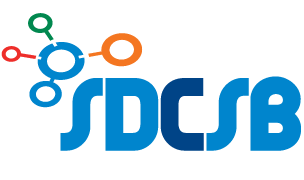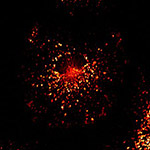Genetics, Bioinformatics and Systems Biology Colloquium
Thursdays, 12:00 pm – 1:00 pm
UC San Diego, Powell-Focht Bioengineering Hall, Fung Auditorium
Complete schedule here
Investigators: Chris Glass, Clodagh O’Shea, Trey Ideker, Bing Ren
A central challenge of molecular biology is to understand how transcriptional regulatory elements are selected from the genome thereby specifying cellular identity and cell-specific responses. The goal of this project is to use systems biology approaches and the maps-to-model paradigm to gain insights into general mechanisms responsible for the selection and function of cis-regulatory elements necessary for transcriptional responses to pathogens.
The SDCSB has previously made substantial progress in understanding how stress remodels transcriptional regulatory networks. The Ren laboratory adapted a high-throughput DNA sequencing method known as Hi-C to investigate how long range chromatin interactions regulate transcription, resulting in the striking finding that functional enhancer-gene interactions occur within megabase-sized topological domains (Jin et al., Nature 2013). The Glass laboratory used both genetic manipulations and natural genetic variations in mice to identify combinations of transcription factors that bind enhancers to affect a gene regulatory response during inflammation stress (Heinz et al., Nature 2013). |
|
In this project, we will map transcription factor binding sites, enhancer-promoter interactions and the 3D higher-order organization of the genome to develop models that predict how cells from different genotypes and tissues respond transcriptionally to pathogenic stimuli. Primary data sets derived from ChIP-Seq, GRO-Seq and conformation capture assays will be used to build context-dependent maps of cis-regulatory elements. We will then develop and apply novel analytical approaches to construct and test models for how enhancers and promoters are initially selected from the genome by combinations of sequence specific transcription factors, how these genomic regions subsequently acquire features of active enhancers, and how active enhancers ultimately communicate with target genes. DNA-DNA interaction networks will also be analyzed for their underlying hierarchical structure.
| The Ideker lab recently developed an innovative new approach, called NeXO (Network-extracted ontologies), which identifies the complete hierarchical structure of modules embedded in a biological network and represents this hierarchy as an ontology (Dutkowski et al., Nat Biotechnol 2013). An improved version of this algorithm, called CliXO (Clique-extracted ontologies), can construct an ontology from any set of quantitative data between elements for which a pairwise similarity score can be defined (Kramer et al., Bioinformatics 2014). Hi-C experiments form such a data set, as an increasing number of reads connecting two genomic regions correlates with a closer position in 3D topological space in the nucleus. This in turn may correlate with functional similarity or cooperation, as we hypothesize that DNA elements in a single topological domain in 3D space are more likely to be functionally related. We are also devising methods to explore whether this chromatin-based ontology can be used to predict transcriptional activity. |
|
It is likely that viruses also target and subvert the 3D landscape of the host genome. Human adenovirus serotype Ad5 is a double stranded DNA virus that induces large-scale changes in cellular mRNA expression, epigenetic marks and nuclear morphology. The activation of viral gene promoters is exquisitely timed in concert with the systems-wide subversion of host transcription. We plan to map the host-viral genome interactions and transcriptional programs, which we predict will play a key role in determining viral tropism and replication.
Recent SDCSB Publications by these Investigators:
- Jado, JC, Dow, M, Carolino, K, Klie, A, Fonseca, GJ, Ideker, T et al.. In vitro evolution and whole genome analysis to study chemotherapy drug resistance in haploid human cells. Sci Rep. 2024;14 (1):13989. doi: 10.1038/s41598-024-63943-7. PubMed PMID:38886371 PubMed Central PMC11183241.
- Abe, Y, Kofman, ER, Ouyang, Z, Cruz-Becerra, G, Spann, NJ, Seidman, JS et al.. A TLR4/TRAF6-dependent signaling pathway mediates NCoR coactivator complex formation for inflammatory gene activation. Proc Natl Acad Sci U S A. 2024;121 (2):e2316104121. doi: 10.1073/pnas.2316104121. PubMed PMID:38165941 PubMed Central PMC10786282.
- Abe, Y, Kofman, ER, Almeida, M, Ouyang, Z, Ponte, F, Mueller, JR et al.. RANK ligand converts the NCoR/HDAC3 co-repressor to a PGC1β- and RNA-dependent co-activator of osteoclast gene expression. Mol Cell. 2023;83 (19):3421-3437.e11. doi: 10.1016/j.molcel.2023.08.029. PubMed PMID:37751740 PubMed Central PMC10591845.
- Ottilie, S, Luth, MR, Hellemann, E, Goldgof, GM, Vigil, E, Kumar, P et al.. Adaptive laboratory evolution in S. cerevisiae highlights role of transcription factors in fungal xenobiotic resistance. Commun Biol. 2022;5 (1):128. doi: 10.1038/s42003-022-03076-7. PubMed PMID:35149760 PubMed Central PMC8837787.
- Troutman, TD, Bennett, H, Sakai, M, Seidman, JS, Heinz, S, Glass, CK et al.. Purification of mouse hepatic non-parenchymal cells or nuclei for use in ChIP-seq and other next-generation sequencing approaches. STAR Protoc. 2021;2 (1):100363. doi: 10.1016/j.xpro.2021.100363. PubMed PMID:33748781 PubMed Central PMC7960533.
- Seidman, JS, Troutman, TD, Sakai, M, Gola, A, Spann, NJ, Bennett, H et al.. Niche-Specific Reprogramming of Epigenetic Landscapes Drives Myeloid Cell Diversity in Nonalcoholic Steatohepatitis. Immunity. 2020;52 (6):1057-1074.e7. doi: 10.1016/j.immuni.2020.04.001. PubMed PMID:32362324 PubMed Central PMC7305990.
- Sakai, M, Troutman, TD, Seidman, JS, Ouyang, Z, Spann, NJ, Abe, Y et al.. Liver-Derived Signals Sequentially Reprogram Myeloid Enhancers to Initiate and Maintain Kupffer Cell Identity. Immunity. 2019;51 (4):655-670.e8. doi: 10.1016/j.immuni.2019.09.002. PubMed PMID:31587991 PubMed Central PMC6800814.
- Fonseca, GJ, Tao, J, Westin, EM, Duttke, SH, Spann, NJ, Strid, T et al.. Diverse motif ensembles specify non-redundant DNA binding activities of AP-1 family members in macrophages. Nat Commun. 2019;10 (1):414. doi: 10.1038/s41467-018-08236-0. PubMed PMID:30679424 PubMed Central PMC6345992.
- Shemer, A, Grozovski, J, Tay, TL, Tao, J, Volaski, A, Süß, P et al.. Engrafted parenchymal brain macrophages differ from microglia in transcriptome, chromatin landscape and response to challenge. Nat Commun. 2018;9 (1):5206. doi: 10.1038/s41467-018-07548-5. PubMed PMID:30523248 PubMed Central PMC6284018.
- Hoeksema, MA, Glass, CK. Nature and nurture of tissue-specific macrophage phenotypes. Atherosclerosis. 2019;281 :159-167. doi: 10.1016/j.atherosclerosis.2018.10.005. PubMed PMID:30343819 PubMed Central PMC6399046.













